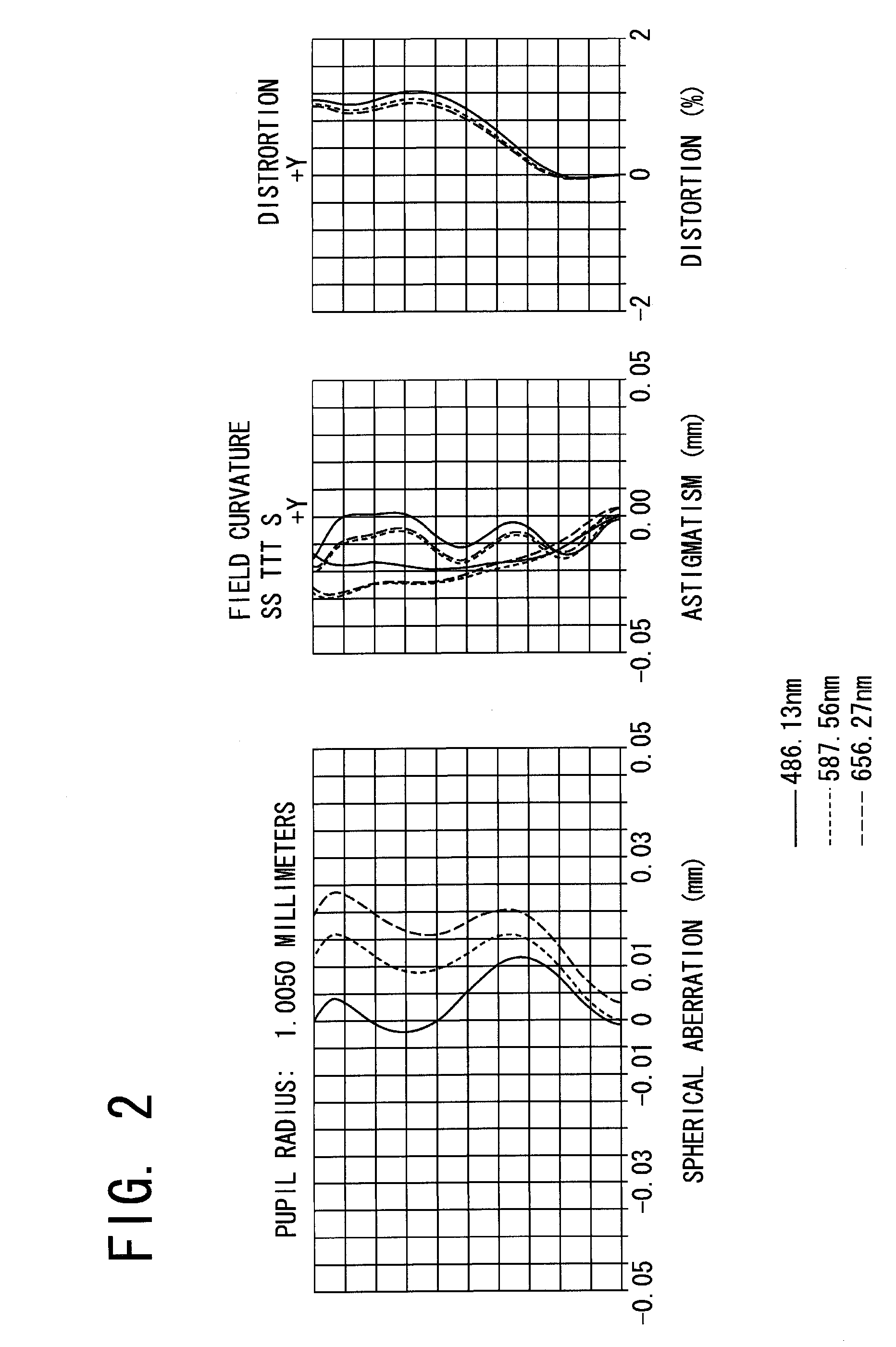Imaging lens unit
a technology of lens unit and image, applied in the field of image lens unit, can solve the problems of difficult to achieve both miniaturization and adequate aberration correction, and difficult to reduce costs, so as to achieve the effect of reducing costs and simplifying the manufacturing process
- Summary
- Abstract
- Description
- Claims
- Application Information
AI Technical Summary
Benefits of technology
Problems solved by technology
Method used
Image
Examples
embodiment 1
[0043]FIGS. 1 and 3 are sectional views of lenses according to Examples 1 and 2 of the first embodiment of the present invention. The basic lens structure is identical between the examples, so the structure of the imaging lens unit according to the first embodiment is explained below referring to the sectional view of the lens unit in Example 1.
[0044]As shown in FIG. 1, in the imaging lens unit according to the first embodiment, the constituent lenses are arranged from the object side to the image side in the following order: an aperture stop S, a first lens L1, second lens L2, a third lens L3, a fourth lens L4, and a fifth lens L5. A cover glass IR is placed between the fifth lens L5 and image plane. This cover glass is omissible. The first lens L1 is a biconvex lens with one convex surface facing the object side and the other facing the image side; the second lens L2 is a lens with negative refractive power lens having a convex surface facing the object side near the optical axis;...
example 1
[0059]Table 1 shows the basic lens data of the imaging lens unit in Example 1.
[0060]
TABLE 1f = 4.8341 Fno = 2.405 ω = 30.463°iRdNdνdS (aperture stop)∞−0.2451*1.9200.6981.53556.22*−4.9890.0233*11.3160.3481.61425.64*1.9500.5825*56.9790.4681.53556.26*51.7980.367*−1.9840.5181.53556.28*−0.9970.20459*12.7830.54281.53556.210* 1.4660.511 ∞0.31.51764.212 ∞1.047IMA∞ikA4A6A8A10A12A141*−8.984E−011.386E−02−4.452E−03−3.635E−036.925E−04−8.637E−04−5.237E−032*−9.222E+01−2.778E−031.138E−02−2.995E−02−1.127E−024.241E−032.486E−033*2.370E+01−2.865E−026.387E−02−5.835E−024.217E−03−2.627E−031.038E−024*−3.288E−01−1.219E−011.557E−01−9.759E−023.109E−02−6.668E−036.555E−035*0.000E+00−1.085E−012.088E−032.471E−026*0.000E+00−8.922E−025.635E−02−4.296E−021.935E−02−2.144E−037*8.968E−014.373E−028.519E−02−5.000E−021.419E−02−7.279E−048*−2.541E+00−1.130E−02−9.215E−042.091E−02−3.309E−03−6.569E−049*2.998E+01−7.461E−02−5.870E−033.201E−035.679E−04−2.374E−05−2.461E−0510* −9.099E+00−7.716E−022.012E−02−5.983E−031.079E−03−9...
example 2
EXAMPLE 2
[0072]Table 2 shows the basic lens data of the imaging lens unit in Example 2.
[0073]
TABLE 2f = 4.82595 Fno = 2.400 ω = 30.484°iRdNdνdS (aperture stop)∞−0.251*1.9200.6791.53556.22*−5.1000.0233*9.0650.36051.61425.64*1.8530.5925*51.0000.4391.53556.26*50.0000.3757*−1.9150.5181.53556.28*−0.9880.1919*9.6790.53081.53556.210* 1.4640.511 ∞0.31.51764.212 ∞1.081IMA∞ikA4A6A8A10A12A141*0.000E+00−1.841E−03−1.651E−021.820E−02−1.883E−022*−8.187E+012.887E−034.435E−03−2.313E−023*2.334E+00−3.108E−026.707E−02−5.101E−021.538E−02−5.459E−034.460E−034*0.000E+00−1.341E−011.587E−01−1.056E−014.540E−02−4.181E−03−8.490E−045*0.000E+00−1.226E−015.463E−032.911E−026*0.000E+00−9.733E−023.206E−021.364E−037*8.240E−013.519E−029.267E−02−4.094E−028.895E−038*−2.462E+00−7.565E−033.357E−032.084E−02−5.920E−039*1.627E+01−6.498E−02−7.256E−032.663E−035.157E−04−1.164E−05−2.080E−0510* −9.192E+00−7.339E−021.842E−02−5.591E−031.022E−03−8.684E−05f3 = −5609.97f5 = −3.2876f12 = 5.782f345 = 25.731EPD = 2.01
[0074]The valu...
PUM
 Login to View More
Login to View More Abstract
Description
Claims
Application Information
 Login to View More
Login to View More - R&D
- Intellectual Property
- Life Sciences
- Materials
- Tech Scout
- Unparalleled Data Quality
- Higher Quality Content
- 60% Fewer Hallucinations
Browse by: Latest US Patents, China's latest patents, Technical Efficacy Thesaurus, Application Domain, Technology Topic, Popular Technical Reports.
© 2025 PatSnap. All rights reserved.Legal|Privacy policy|Modern Slavery Act Transparency Statement|Sitemap|About US| Contact US: help@patsnap.com



